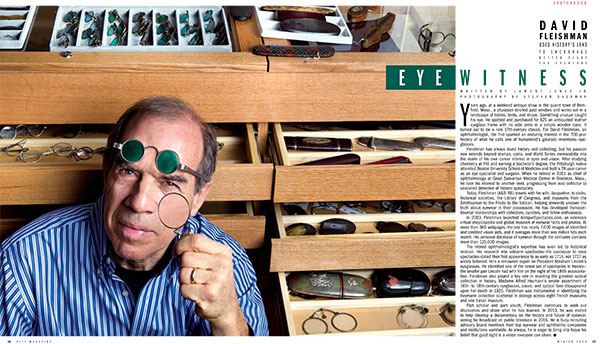Years ago, at a weekend antique show in the quaint town of Brimfield, Mass., a physician strolled past vendors and wares set in a landscape of tables, tents, and shops. Something unusual caught his eye. He spotted and purchased for $25 an antiquated leather eyeglass frame with no side arms in a simple wooden case. It turned out to be a rare 17th-century classic. For David Fleishman, an ophthalmologist, the find sparked an enduring interest in the 700-year history of what he calls one of humankind’s greatest inventions—eye glasses.

Fleishman has always loved history and collecting, but his passion now extends beyond stamps, coins, and World Series memorabilia into the realm of his own career interest in eyes and vision. After studying chemistry at Pitt and earning a bachelor’s degree, the Pittsburgh native attended Boston University School of Medicine and built a 28-year career as an eye specialist and surgeon. When he retired in 2001 as chief of ophthalmology at Good Samaritan Medical Center in Brockton, Mass., he took his interest to another level, progressing from avid collector to seasoned detective of historic spectacles.
Today, Fleishman (A&S ’65) travels with his wife, Jacqueline, to clubs, historical societies, the Library of Congress, and museums from the Smithsonian to the Prado to the Vatican, helping stewards uncover the truth about eyewear in their possession. He has developed transcontinental relationships with collectors, curators, and fellow enthusiasts.
In 2003, Fleishman launched AntiqueSpectacles.com, an extensive virtual encyclopedia and global museum of eyewear facts and photos. At more than 360 webpages, the site has nearly 7,000 images of identified and credited vision aids, and it averages more than one million hits each month. His personal database of eyewear through the centuries contains more than 125,000 images.
The retired ophthalmologist’s expertise has even led to historical revision. His research into sidearm spectacles–the successor to nose spectacles–dated their first appearance to as early as 1714, not 1727 as widely believed. He’s a renowned expert on President Abraham Lincoln’s eyeglasses. He identified one of the rarest set of spectacles in history—the smaller pair Lincoln had with him on the night of his 1865 assassination. Fleishman also played a key role in reuniting the greatest optical collection in history. Madame Alfred Heymann’s ornate assortment of 16th- to 18th-century eyeglasses, cases, and optical fans disappeared upon her death in 1925. Fleishman was instrumental in identifying the Heymann collection scattered in storage across eight French museums and one Italian museum.
Part scholar and part sleuth, Fleishman continues to seek out discoveries and share what he has learned. In 2013, he was invited to help develop a documentary on the history and future of eyewear, aiming for broadcast on public television in 2015. He is busy recruiting advisory board members from top eyewear and ophthalmic companies and institutions worldwide. As always, he is eager to bring into focus his belief that good sight is a vision everyone can share.













